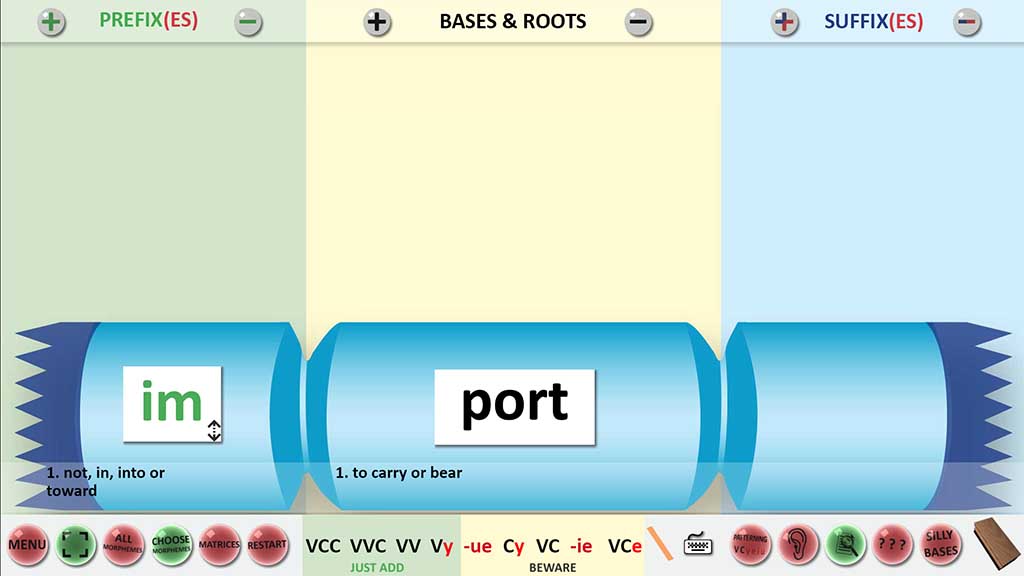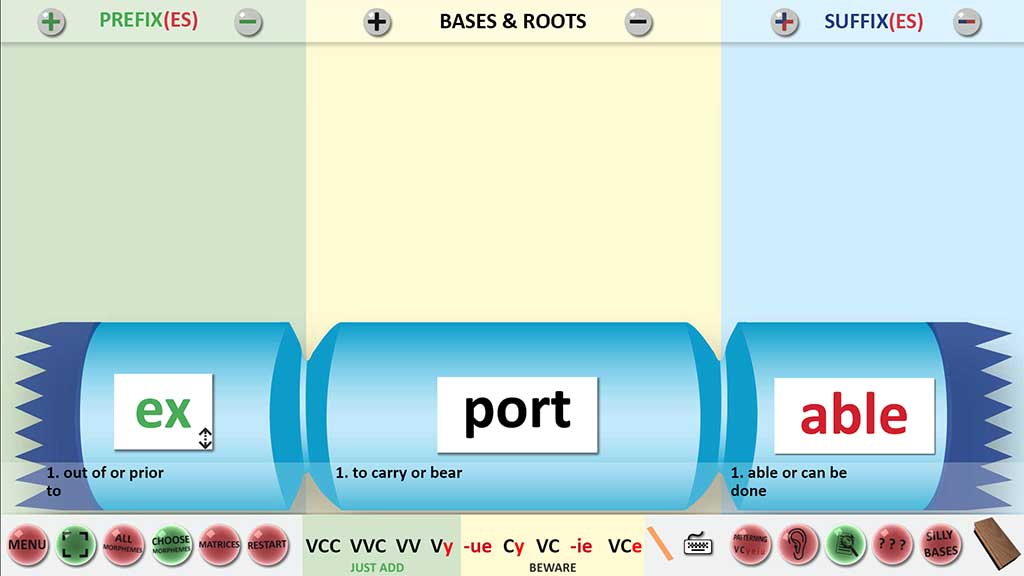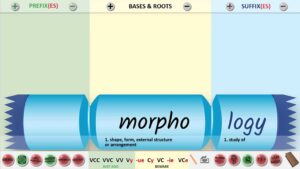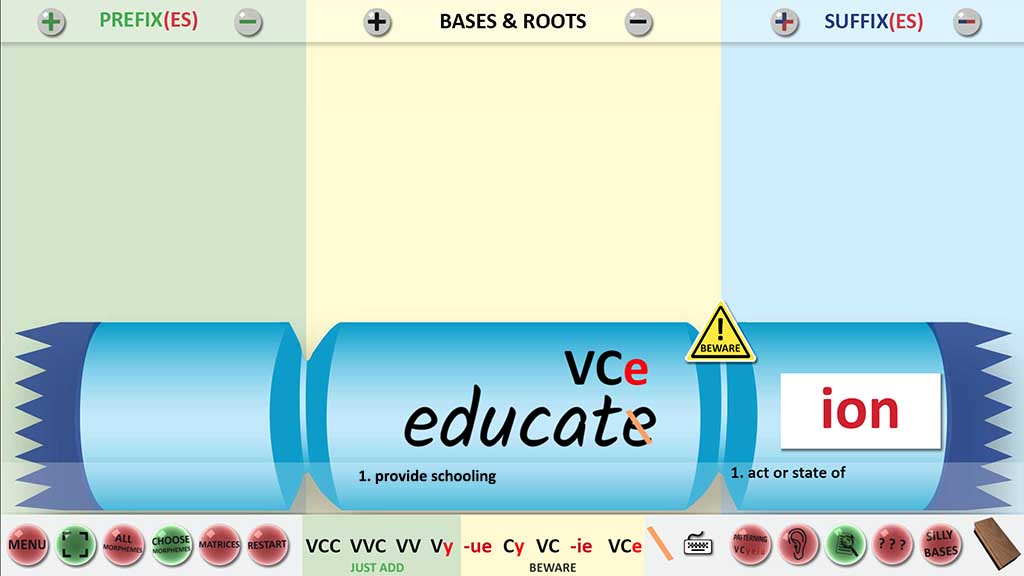So, your teachers are talking to you about teaching morphology. Maybe your response is “whatology?” (like mine would have been when I was a member of a school leadership team). It’s excellent news that your teachers want to be able to be resourced to teach morphology better. In this article, I want to help you understand the importance of your teachers being knowledgeable in this area and why they want to teach it well.
Before going into it, I want to begin by thanking you for allowing the shift to evidence-based literacy practices in your school. Perhaps you initiated it. If you did – bravo. In most cases, however, the shift in pedagogy has come from teachers. Some might argue that this is exactly how such an important change in how we teach should take place.

Evidence based is finally catching on
The reading wars are now drawing their final breath as schools, like yours, are beginning to deliver reading, spelling and writing results that eclipse results from before your teachers tightened their teaching practices and aligned them with science and what we know about how brains learn. The jury is now in, in your school, and schools across the English-speaking world. Its finding? Whole-language and balanced literacy teaching methods are simply not effective enough for enough kids. Research stretching back to the 1970s tells us exactly why we are seeing the results we’re seeing in schools who are embracing evidence-based literacy teaching practices. Developing a love of reading in kids just isn’t cutting it. Over the last fifteen years I’ve been right there in the mix, either being directly involved with, or observing (on study tours) trailblazing schools doing their incredible work in bringing their teaching in line with the evidence.
If you want to read more about this, I refer you to one of my blogs on these schools and what they have in common.
Education’s research allergy
Education, the giant beast it is, is historically allergic to research and tends to, very vulnerable to bright and shiny, well marketed new stuff. It traditionally also favours ideology over evidence. Do you remember those essays you wrote in university about different philosophies of teaching, not one peer-reviewed article in your reference list? In a vacuum of evidence, university course coordinators wasted our time and money as they built the syllabus around helping us emerging educators to form our professional identities (please!) None of this helped us when we stood in front of that class for the first, (and subsequent) times. Our teacher education certainly let us all down. Every one of us should have left teacher training knowing exactly what morphology is. Sadly, we didn’t! Cognitive Neuroscientist, Mark Seidenberg, in his game-changing book “Language at the Speed of Sight” describes this debacle with surgical precision:
“The distortions in how science functions in education reflect what happened when an isolated, inbred community of scholars and practitioners developed an arms’ length stance toward research. The field then turns out practitioners who lack the tools to evaluate what they are taught about issues such as how children learn to read. Absent these tools, they are forced to rely on personal experience, or the assurances of authorities, whose reliability is difficult to assess. Or the treacherous Internet, where some experts teach the claims made in the Cmabridge reading hoax as true. (Seidenberg 1998:286)“
And, no, that’s not s typo in the last line – look it up.
Show me the evidence!
Nowadays, many school leaders have a much better feel for Science of Reading / Science of Learning (both catchy little brand-phrases that will get us all into trouble at some point as corporate edu-marketers start using them), but for the time being, you know what I mean. Leaders have a better radar for educational snake oil and can generally sort the science from the scat. They are also (rightly) very wary of anything that seems new and shiny and are asking teachers to provide evidence that something is evidence based! The good news about morphology is that it’s not new. It’s been hiding in plain sight all along, aiding your comprehension, helping you chunk words to help you read and spell with more accuracy and ease. It’s been determining words’ grammatical function and secretly adding odd-looking letter strings to your sight-word bank and embedding their hidden meanings into your semantic lexicon (vocabulary) without you even knowing it! Morphology is why you know that the words ‘dictation’, ‘dictate’, ‘dictionary’ and ‘diction’; ‘psychiatrist’ and ‘podiatrist’; ‘happy’, ‘happen’, ‘hapless’ and ‘haphazard’ are related in meaning in a way that you’ve never quite been able to put your finger on. Now you’re looking closely aren’t you! These words all contain bases (which are morphemes) that mean something:
- ‘dict’ is a bound morpheme meaning ‘to speak’
- ‘iatr’ is also a bound morpheme that means ‘to heal’
- ‘hap’ is a free morpheme that was once used in every day speech to mean ‘luck’
With knowledge of these bases, we can now add different affixes (prefixes and suffixes) to change the meaning slightly, and/or change the word’s part in speech (its grammar).
You’ve possibly just had your vocabulary increased by a few hundred words and have had your comprehension boosted for any clause or sentence you read in the future with these three morphemes. You’re welcome!
NOTE: The first few words in each list have their bases, prefixes and suffixes colour coded following the Word Cracking colour coding system.
Base ‘hap’ meaning luck
happy
happen
mishap
hapless
happens
happyier
happily
mishaps
perhaps
unhappy
happened
happiest
haphazard
happening
happiness
slaphappy
unhappier
unhappily
happenings
unhappiest
haphazardly
unhappiness
happenstance
Base (root) ‘dict’ meaning to speak
dicta
edict
addict
dictum
indict
addict
dictate
diction
dictums
indicts
predict
verdict
addicted
dictator
indicted
predict
addiction
addictive
dictation
dictators
indicting
interdict
predictor
addictions
(I stopped here – there are about 30 more)
Base (root) ‘iatr’ meaning to heal
pod+iatry (pod=foot)
ger+iatric (ger=old person)
paed+iatric (paed=child)
ger+iatrics
pediatrics
podiatrist
psychiatry (psych=mind)
paediatrics
podiatrists
psychiatric
geriatrician
peadiatrician
psychiatrist
geriatricians
paediatrician
peadiatricians
psychiatrists
paediatricians
As well as all this, morphology has also determined our language’s most important and complex spelling rules. Ever heard of the Big-3 spelling rules? They explain why we drop the letter ‘e’ before adding ‘ing’ (and any other vowel suffix). It’s why a second letter ‘n’ appears when ‘run’ becomes ‘running’ and why the title of the 2006 Will Smith movie “The Pursuit of Happyness” is an awful example of the USA massacring the spelling system. Sorry Americans, actually – not really sorry!
Morphemes have been right there, in our words, all along, providing readers with all sorts of important information in the form of affixes, that can tell us when something happened: ‘ing’ / ‘ed’ / ‘pre’), how many of something: (‘s’ / ‘es’) or, what someone or something does (‘er’ / ‘or’). Morphology also gives the reader important information about the base meaning of words like transportable, that is made of three morphemes, telling us that:
- something is able…suffix ‘able’…
- to be carried…base ‘port’ …
- across or through something…prefix ‘trans’


English is a Morphophonemic Language
morph: a base meaning shape or form (morpheme #1)
o: connecting vowel – not a morpheme
phon: a base meaning speech sound (morpheme #2)
eme: a vowel suffix meaning smallest unit of (drop the ‘e’) (morpheme #3)
ic: a vowel suffix that forms an adjective from a vowel (morpheme #4)
The online Word Cracker clearly shows the bases and the suffixes that make up ‘morphophonemic’

One thing that the adjective morphophonemic (with its four morphemes) tells us, is that to read, comprehend, spell and write within our writing system, we need to be across the phonemic part of the spelling system. This is how sounds (phonemes) map onto letters or groups of letters (graphemes) that represent them in print. We also need to be across the morphemic part of our spelling system. This is how words consist of units of meaning.
Many of the irregularly spelled words (the ones we sloppily refer to as tricky words or heart words), have their irregularities explained by their morphemic structure. The word ‘says’ is actually the base ‘say’ suffixed with the letter ‘s’. What has changed is the pronunciation. The word ‘does’ is base ‘do’, suffixed with (you’ve already spotted it), but again, there’s a shift in pronunciation. This happens regularly in English. Many teachers battle away with kids, trying to get irregular words into their long term memories. Understanding the morphemic structure of words like these adds another memory hook to aid spelling, particularly for students with spelling difficulties (diagnosed or otherwise).
Phonics, (the phonemic part) of our spelling system is concerned with explicitly teaching how phonemes (the smallest units of speech sound) map onto graphemes (the smallest units of spelling that represent phonemes in print). Morphology is interested in another ‘eme’: morphemes – the smallest units of meaning in a word. Once teachers become confident with teaching the phonology part, they go looking for ways to teach the morphemic structure of language. That is what’s happening in your school. Most phonic scopes and sequences include common affixes (prefixes and suffixes), in line with the phonic sequence being used. Many schools (rightly) build a morphology scope end sequence into their spelling, as morphology and spelling are inseparable. If by now you are starting to think less about what you’re reading and more about “I wonder what the morphemes in inseparable are”, then congratulations, you’ve officially crossed over to the dark side and there’s no way back! So, why would I deny you? Let’s go there using the Word Cracker!

Let’s conclude (clude = shut)
So, there you have it! I don’t think I need say any more to convince you that morphology is inseparable from structured literacy teaching. It is not new and it certainly isn’t the next new shiny, non-evidence based fad. Morphology has been with us all along. Typically developing readers and spellers develop an awareness of it without really understanding it. Those of us working with young people in the learning difficulties space have needed to explicitly teach morphology, alongside structured synthetic phonics, in a highly structured and fine-grained way to help students gain a foothold in the more complex layers of our language. As it turns out, structured morphology teaching is not only helping struggling students, it is lifting the top performing students as well.
Morphology is an amazingly powerful and incredibly deep (‘cred comes from ‘crede’, meaning to believe as in credibility) section of our spelling system (‘sect’ means to cut as in dissect). So when your teachers come asking about being better resourced to teach morphology – you can back them with absolute confidence (fide = trust).


